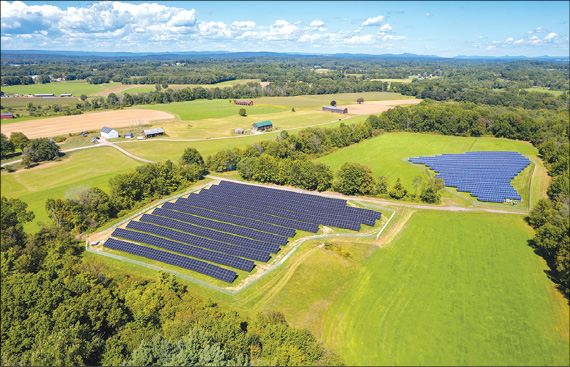Perched atop hills on the west side of the Suffield Academy campus are two solar arrays that have the capacity to produce enough electricity to power about half of the school’s annual 4-million-kilowatt-hour needs, according to Chief Financial Officer Patrick Booth.

Two Suffield Academy solar arrays are located about a 10-minute walk west of the main campus, accessible via a service road off Hill Street.
Installed in 2020, the original array spans 1.94 acres and comprises 1,764 panels, each with a capacity of 340 watts. It is currently generating about 750,000 kWh of electricity annually, he said. That’s roughly enough electricity to power about 64 average-sized homes annually, based on Dominion Energy data.
A second array, just completed and not yet operational, sits on 2.77 acres adjacent to the first and separated by a tree-lined gravel access road. It consists of 1,680 panels, each with a capacity of 590 watts. It will generate approximately 1.2 million kWh of electricity annually, or roughly enough electricity to power about 101 average-sized homes each year.
The panels are expected to last 20 to 25 years, although their electricity-generating capacity will diminish as they age, said Booth.
However, the academy is not using the full potential of all its panels for its electrical needs. The original array is directly connected to the Tisch Field House and meets most, but not all, of its needs. A developer built and maintains the solar field. The firm charges the school 5¢ kWh. In 2035, the academy can purchase the array for one dollar, Booth said.
The second array, which the academy built itself for about $3 million, will be connected to the electric grid early next year by Eversource, Booth said. The utility will compensate the academy for the electricity, about $150,000 annually, he noted. The school chose not to connect the panels to the campus after weighing a combination of factors, including a federal tax credit incentive, a new state metering tariff program and the power loss that would occur on the line over the long distance to the main campus.
He emphasized that the construction of both arrays was made economically feasible only through generous donations, particularly from the Willow Springs Foundation, as well as contributions from other benefactors and the school’s Parents’ Association Auction. He praised the Town of Suffield for its support throughout the process.
The academy spotlights its commitment to sustainability on its website, which also features a dashboard displaying the power output of the first solar array in real-time, along with the CO2 emissions it’s prevented and related data. You can view it at https://shorturl.at/HwLoR.
Earlier this year, I reported on another one of the academy’s sustainability initiatives: its six-year-old dining room food waste recycling program. The program collected over 32 tons of food scraps during the last school year, thanks to the efforts of Food Service Director Sean Hennessey and his team.